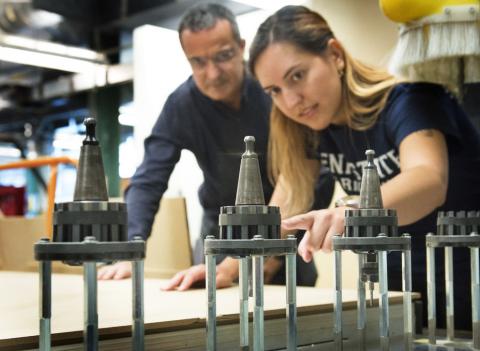
Penn State’s research expenditures reached a record high for the second consecutive year in fiscal year 2017-2018, according to Vice President for Research Neil Sharkey. The $927 million total represents a $64 million increase over last year’s figure, and includes a record $562 million in federal funds and $365 million from a combination of private funders, the Commonwealth, and University sources.
Sharkey cited a 14 percent increase in defense-related funding and an 11 percent rise in funding from industry, foundations, and other sponsors as major factors in achieving the record total.
“Our defense funding levels demonstrate the continuing confidence the Department of Defense has in our research, a partnership of trust that has been decades in the making,” Sharkey said. “The jump in private funding shows how much effort we’ve been putting into translating our work into real-world impacts and supporting the private sector.”
Federal funding went from $534 million to $562 million, and while a $28 million increase from the Department of the Navy accounted for the bulk of that rise, the University also enjoyed increased support from the National Institutes of Health, NASA, and the Department of Energy, Sharkey noted. Research funding from the Commonwealth of Pennsylvania fell slightly, from $75 million to $73 million, while funding from industry, foundations, and other sponsors climbed from $91 million to $101 million.
Some notable examples of federally sponsored projects were a study funded by $7 million from the Department of Energy to develop deep-rooted crops that can thrive in conditions of rising temperatures and drought, a study funded by over $11 million from the National Institute on Drug Abuse for analysis of complex behavioral data related to substance abuse and HIV, and a $3 million grant from the Department of Energy to create intelligent vehicle networks that reduce fuel used by trucks and other heavy vehicles.
Among the University’s academic research units, the College of Health and Human Development saw a 25 percent increase in funding, to $60 million; The Eberly College of Science was up 10 percent, to $129 million, and the College of Agricultural Sciences rose 7 percent, to $121 million.
Sharkey noted that $191 million, almost 21 percent of total expenditures, is accounted for by the University’s own investment in research for the public good, an integral part of its land grant mission, including substantial investments in new facilities and instrumentation “that enable our investigators to be the best they can be, thus attracting highly competitive federal dollars.”
In sum, “Our record funding level reflects the hard work and ingenuity of our world-class faculty, students, staff as well as a renewed enthusiasm in Washington for federally supported research and development,” Sharkey said.